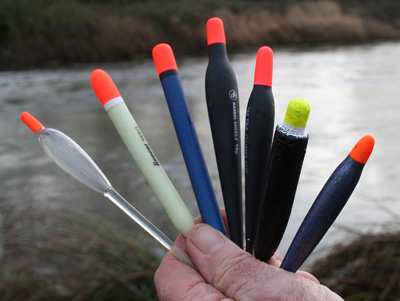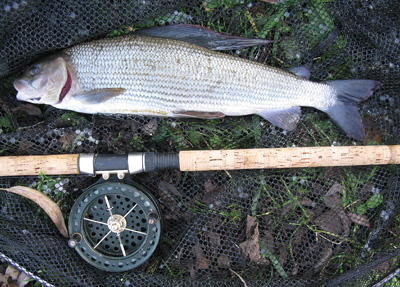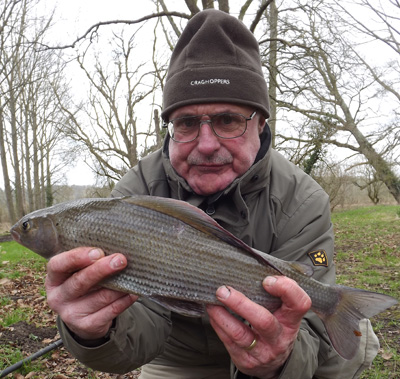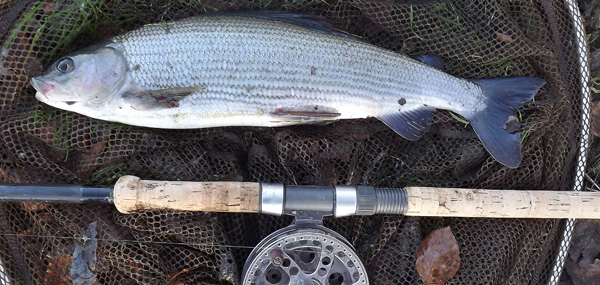For the past few years I have been privileged to be able to coarse fish a prime stretch of the lower River Test in winter. I have caught specimen roach, chub, and, of course, grayling and it has all been a bit of an adventure!
Few anglers have specialised such that they have been able to write with any real authority on grayling and I do not by any stretch of the imagination claim to be one of those few, but I think I may have a few useful thoughts and ideas to pass on.
Winter grayling fishing to me means float fishing, more specifically float fishing with a centrepin. A few anglers favour quiver-tipping, something I try to avoid, not just because I prefer to float fish but also because I am worried about fish being deep-hooked on the tip; deep hooking can be a problem at the best of times, even on float tackle, so you will get plenty of practice in using your forceps and disgorger. Fly fishing with a leaded nymph in winter is also popular and is something I have put on my personal list of techniques to get to grips with.
 As far as tackle is concerned what I recommend may well seem on the heavy side but fast flows, deep swims and big fish of all kinds abound in the venue I fish so nothing less than 4lb test all through will do, although I prefer a 5lb reel line and 4lb hook length. As far as floats are concerned I carry a range, including fairly heavy ones with a capacity of anything from 3BB to 4SSG and because of the nature of the water, and length of trot, in some swims for visibility they must have what the late Richard Walker called ‘good fat tips’: commercially available chubbers, Avons and loafers are all suitable.
As far as tackle is concerned what I recommend may well seem on the heavy side but fast flows, deep swims and big fish of all kinds abound in the venue I fish so nothing less than 4lb test all through will do, although I prefer a 5lb reel line and 4lb hook length. As far as floats are concerned I carry a range, including fairly heavy ones with a capacity of anything from 3BB to 4SSG and because of the nature of the water, and length of trot, in some swims for visibility they must have what the late Richard Walker called ‘good fat tips’: commercially available chubbers, Avons and loafers are all suitable.
I also use my own home-made chunky balsa and dowel ‘chubbers’ (capacity 6 to 8 SSG) with tips of 12mm or more wide…But more of this later. My shotting pattern is simple: a BB a foot or so above the hook as an indicator, the remainder bulked a foot above that – a classic fast water trotting rig.
Suffice it to say that when my float takes a dive, I am likely to connect with a decent fish of one kind or another, and it will give a good account of itself even on the gear I use. Quite commonly when a swim is fed, brown trout will move in, if they are not already resident, and I have had several of these ‘nuisance’ fish to well over 5lb in quite superb condition, and believe me they can take a bit of dealing with! Hopefully though some of the fish I connect with will give the characteristic ‘thump-thump’ of a big grayling…
To deal with big fish of various kinds I usually use a fairly powerful 15ft float rod – a shorter one where trees are in the way – the minimum length I have any use for is 14ft, but more usually 15 or even on occasion 17ft. A long rod is useful to overcome the problem of marginal vegetation; it also helps when controlling a float and striking at distance and is an advantage when fishing a very deep swim. It can be hard work, but so what? A specimen grayling or two makes it all worthwhile.
Swims? These can be anything from the classic streamy glide which delights those who love to trot a float to the slowly-moving eddy; and all sorts of odd pockets of water between. One thing I have noticed though, but this should not really come as a surprise, is that the bigger fish often prefer areas where they can conserve energy. Like several other species grayling will often favour swims where there is pacey water and a slack area on hand that they can retreat into so eddies and slacks, even the smallest ones, should never be ignored, and are often worth searching very carefully.
 Sometimes it is well worth searching across as well as along a bit of river in order to locate grayling. The fish often hold station in channels and near other features which are not too apparent from the bank. The large home-made chubbers I mentioned earlier come into their own when searching out such areas, as does an efficient catapult for loose feed. A long rod is also a help when lobbing out a large float in the direction of a possible holding area and it also helps with effective float control. The thick tip aids visibility no end, and the fish will not mind it in the slightest and if they are interested, the float will do its usual disappearing act.
Sometimes it is well worth searching across as well as along a bit of river in order to locate grayling. The fish often hold station in channels and near other features which are not too apparent from the bank. The large home-made chubbers I mentioned earlier come into their own when searching out such areas, as does an efficient catapult for loose feed. A long rod is also a help when lobbing out a large float in the direction of a possible holding area and it also helps with effective float control. The thick tip aids visibility no end, and the fish will not mind it in the slightest and if they are interested, the float will do its usual disappearing act.
Another factor is that grayling will, under certain conditions, leave the swims where they are normally resident, and look for shallower or streamier water. This in fact happened where I fish during the latter part of the 2011/12 ‘drought winter’. Those who persisted with the normally recognised swims caught very few grayling; those few however who wandered about fishing alternative areas – usually shallow – were frequently rewarded.
To cope with trotting very shallow water I have seen the Billy Lane ‘Trent trotter’ style of float rig put to good effect. This involves the use of a short float (a chubber is ideal) fished bottom end only. Although Billy advocated fishing the float on a loop of the reel line formed by pinching together the doubled line with a shot, perhaps a more user-friendly version might be to fix a clip swivel or float adapter in place with locking shot and attach the float to this. Billy also recommended back-shotting to sink the line more efficiently. This rig is certainly worth giving more than a token whirl in shallow water. It is of course limited to near-bank swims. Another suitable type of float for this rig is a modern pellet waggler but whichever you opt for do not attempt to mend line or control the float in any way – just let it go downstream.
As with all chalk stream float fishing, false bites from weed can prove a problem, but occasionally you will be pleasantly surprised on striking.
 Baits? One bait I have never found of much use for grayling fishing is breadflake, but a couple of maggots on a 16 or a single piece of corn on a 14 will cover most eventualities. However, I am now certain in my own mind that grayling, despite their popular image as willing and voracious feeders, do in fact wise up like any other fish, hence change baits or unusual baits can really score on occasion.
Baits? One bait I have never found of much use for grayling fishing is breadflake, but a couple of maggots on a 16 or a single piece of corn on a 14 will cover most eventualities. However, I am now certain in my own mind that grayling, despite their popular image as willing and voracious feeders, do in fact wise up like any other fish, hence change baits or unusual baits can really score on occasion.
Two traditional baits I have used to good effect are pearl barley and stewed wheat – both useful particle baits which sink reasonably quickly in fast water. Cheese, in the form of standard pre-packaged supermarket Cheddar, also works well for me on the float and it can be simply moulded on the hook straight from the packet with small compressed pieces used as feed.
When the water is up and coloured a bit of smelly groundbait and hemp in small balls to take the feed down can make all the difference. In clear water, liquidised bread laced with your choice of flavouring (I use off-the-shelf powdered garlic) can be used to take the loose feed.
Yes, grayling do have very catholic tastes and feed as much by scent as by sight at times, so it is up to you to experiment…
As far as loose feed is concerned, my general advice is to keep the quantity to a minimum. Occasionally grayling do, it is true, seem intent on devouring everything which comes their way but I have found the old-fashioned (but effective) rule of ‘little and often’ works best.
One special plea: grayling (particularly big ones of 2lb and over) are particularly vulnerable when returned, they really do gives their all when hooked. To prevent them going belly-up and being swept downstream, support them for as long as necessary with their head facing upstream so that they can recover. Getting two hands to the job will helps and you can feel the fish kick strongly when it’s ready for the off.
Smaller fish up to a pound or so can be returned very effectively by simply dropping them back in head first from a foot or so above the surface; this gets them back into their element with a much-needed surge of water through the gills.
As a species grayling have all too often been looked down upon, persecuted as vermin, or trivialised as a reserve species to fly fish for after the end of the trout season – a second-class game fish in other words. The reality is that grayling are a worthwhile quarry, and deserve to be conserved as a species.

A day’s grayling fishing on the float is for me an opportunity to get away from the now virtually standard type of totally static, chair-bound and largely unimaginative coarse fishing. I prefer to be mobile wherever possible in all of my fishing and a day spent trotting for grayling fulfils this requirement perfectly. And, of course, it is a perfect opportunity to travel light: one rod, a minimum of tackle in a smallish bag, and a landing net, which itself can be used to carry a small selection of baits when on the move.
Now is the perfect time to get out, get mobile and to experiment with your grayling fishing you may just be surprised…










